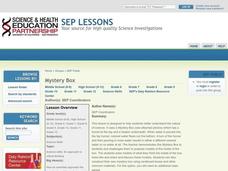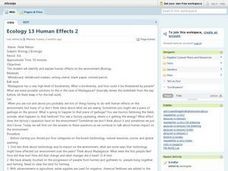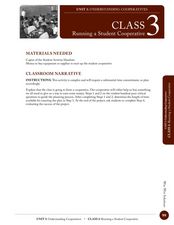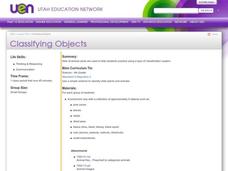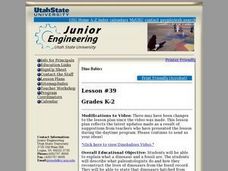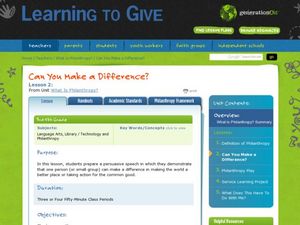Curated OER
Mystery Box
Students explore why scientists use models to help them explain things that cannot be seen. In this predictions lesson students make a prediction based on observations and collected evidence.
Curated OER
Physicists or Philosophers?
Trace the sequential process of the developing theories of atomic structure in the early 20th century, show, in historical development, how scientists "know" things, how experiments are set up and how interpretations are drawn from them,...
Curated OER
Disease and Epidemics
High schoolers explore how the study of diseases, epidemics and disease management offers opportunities for exploration of biological evolution, immune systems, interaction between humans and their environment, and interaction among...
Curated OER
Extensions - Biology Review Unit
Students engage in a variety of activities in order to review a Biology unit. For example, they research the Bird Flu, it's history, how it is spread, what has been done about it, what better options exist for controlling or removing it....
Curated OER
Ecology 13 Human Effects 2
Students identify and explain human effects on the environment. They explore the terms biodiversity, natural resources, ozone and global warming. After exploring all the terms , they connect technology to them and how it effects the...
Curated OER
Beaver Ecology
Learners explore the lives of bgeahvers. They identify the physical and behavioral adaptations that help beavers survive in their environment. Students compare and contrast how beavers influence the ecology of both forest and aquatic...
Curated OER
The Nervous System Lesson
Students identify features of the nervous system. They explore the needs of the human body by explaining the importance of good health in relationship to the body and explain the functions and care of the human body and its organs.
Curated OER
The Human Body
Students research information about the human body. They read books and explore the Internet to gather information about the human body. Students create graphic representations and models of the body systems. Working in groups, they...
Curated OER
Similar And Different
Learners take part in a lesson that is composed of team building activities. They work in small groups in order to interview others to find information to point out similarities or differences. Students then take part in class discussion...
Curated OER
Running a Student Cooperative
Students form a classroom cooperative. In this service learning lesson plan, students explore how to form and run a cooperative and decide as a class how to implement their cooperative plan. Students use funds raised from the...
Curated OER
Primary & Secondary Colors
Young scholars gain the knowledge of how to create color/s. This is relevant in their lives as they will forever be exposed to color and learning to identify how color is created.
Curated OER
Task-based Grammar Teaching
Pupils compare a photo of themsevles now to a photo from ten years ago. They write how their life was different then from now and then present the information to the class.
Curated OER
Classifying Objects
Fourth graders work in small groups to sort and classify a variety of objects. They develop criteria for sorting and explain the characteristics they chose for classification. Groups record and share their classifications.
Curated OER
Cytoskeleton of a Cell
Learners examine the cytoskeleton of a cell. They work together to build a structure with a certain number of materials. They share their "cell" with their classmates.
Curated OER
What are Conductors and Insulators?
Students explore simple circuits. Students conduct a variety of experiments to discover their level of conductivity. Students summarize and explain experimental findings. Students are introduced to passive causality.
Curated OER
Physical Science: Solar Energy
Students review and discuss how Solar energy and electricity produce light and heat. They create a photo/picture journal and include pictures taken during solar energy activities to a PowerPoint slide presentation.
Curated OER
Ecological Relationships
Middle schoolers identify ecological elements and their factors on species, populations and food webs. They analyze ecosystems for these elements and research how these factors influence species survival rate. Predictions on conditions...
Curated OER
Hit a Homerun with Reading Speed
Students review basic reading decoding/comprehension. They read passages and see how fast they can read the pages. In a baseball-like game, they try to read faster and faster. If they improve their fluency rate, they increase their...
Curated OER
Tessellations Lesson
Fifth graders demonstrate their understanding of tessellations by watching a teacher prepared Powerpoint presentation and completing an activity. The students work independently to identify tessellations.
Curated OER
introduction
Students participate in a lesson that is intended for the first days of school. They are led through introductions and how the class is organized for working on a daily basis. They sign behavior contracts and other paperwork as directed...
Curated OER
Dino Babies
Students distinguish between dinosaurs and fossils. They escribe what paleontologists do and how they reconstruct the lives of dinosaurs from the fossil record. In addition, they state that dinosaurs hatched from eggs.
Curated OER
Cinco de Mayo - A Patriotic Mexican Holiday
Third graders study Cinco de Mayo as a patriotic Mexican Holiday. First, they work in pairs to write about and illustrate one thing they do on the Fourth of July. They listen to a reading about Cinco de Mayo before writing about and...
Curated OER
Can You Make a Difference?
Students write and present a speech. In this service lesson, students read an anecdote adapted from The Star Thrower and discuss their feelings about their ability to make a difference in the world. Students make a short speech about...


